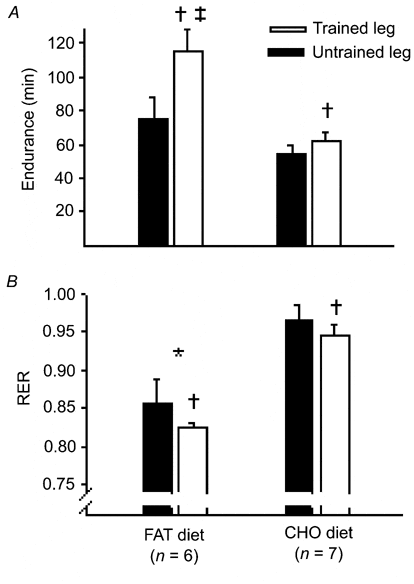Fat diet adaptation has been used as a magic bullet to enhance endurance performance in humans, but has in most cases failed to do so (Helge, 2000). However, several muscle adaptations occurring after fat adaptation would implicate that performance should be increased, at least at the muscle level (Helge, 2000). In this study our aim was to investigate the effect of training and fat or carbohydrate diet on endurance performance when exercise is performed only with a limited muscle mass.
Thirteen untrained males trained the knee extensor of one leg for 4 weeks while the other leg served as control. Training intensity was set from the measured one-leg Wmax and after 14 days Wmax was measured again and intensity justified accordingly. Training was performed on 18 days and the total amount of training was 31.5 h. During the 4 weeks six subjects consumed a high-fat diet (58 % fat, 24 % carbohydrate and 18 % protein) and seven a carbohydrate diet (32 % fat, 55 % carbohydrate and 12 % protein). Before and after 4 weeks, muscle samples were obtained from m. vastus lateralis. After 4 weeks a one-leg endurance test until exhaustion was performed at 95 % of Wmax on separate days. Two-way ANOVA was applied and data are expressed as means ± S.E.M. Ethical approval with informed consent was obtained.
Endurance performance was higher in the trained leg compared with the untrained leg after both FAT and CHO diet (P < 0.05), but more so after the FAT than the CHO diet (P < 0.05, Fig. 1A). (Endurance performance in the untrained leg in FAT was also measured before the experiment and was unchanged across the 4 weeks.) During exercise respiratory exchange ratio (RER) was significantly lower after the FAT than the CHO diet and lower in the trained than the untrained leg (P < 0.05, Fig. 1B). During exercise average heart rate was similar in the trials: 110 ± 2 b.p.m. After the 4 weeks citrate synthase (CS) activity was significantly increased in the trained leg after FAT and CHO diet (15 %), respectively (P < 0.05), whereas it remained unchanged in the non-trained leg. In contrast, β-hydroxy-acyl-CoA-dehydrogenase (HAD) activity was not affected by either diet or training over the 4 weeks. Initially Wmax was higher in the FAT than the CHO group, 44 ± 3 and 55 ± 3 W, respectively (P < 0.05). In conclusion, endurance performance was significantly higher after fat diet and training than after carbohydrate diet and training, thus suggesting that when a limited muscle mass is involved, fat diet and training may in fact enhance endurance performance. The apparent discrepancy when compared with the effect of fat diet on whole body exercise performance is not clear from the present data.

